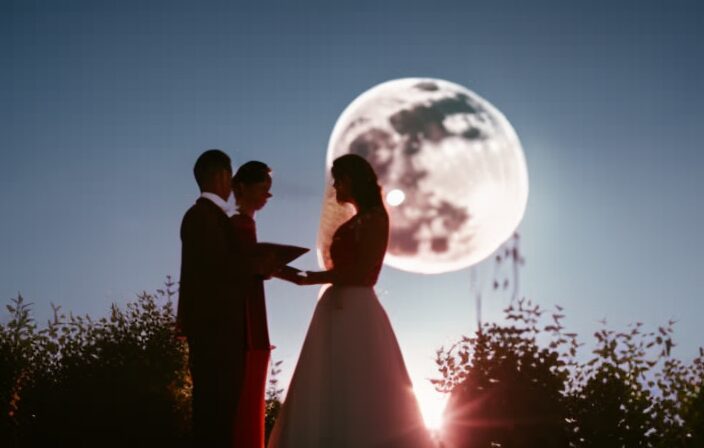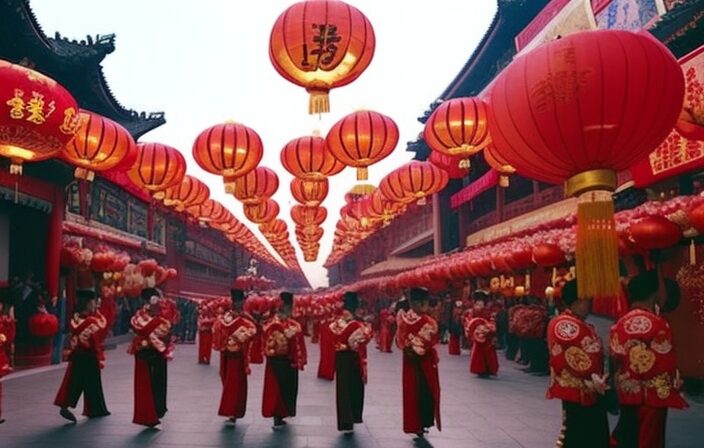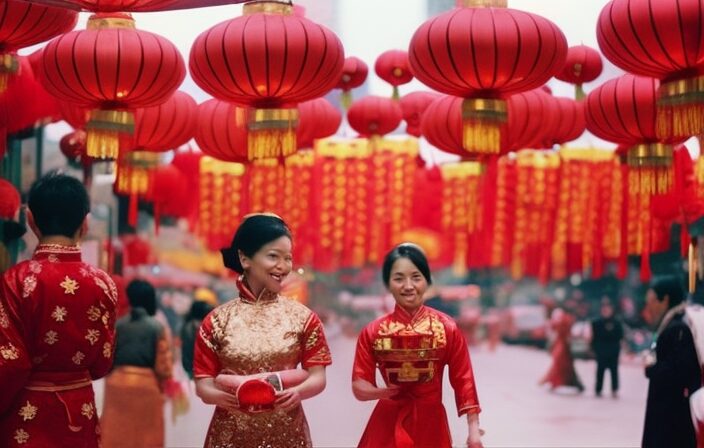When the vibrant hues of the Lunar New Year illuminate the night sky, traditional dance takes center stage, weaving a tale that transcends time.
Like a delicate brushstroke on a canvas, these captivating movements embody the essence of cultural heritage and celebration.
This article delves into the role of traditional dance in Lunar New Year festivities, examining its origins, symbolism, and preservation.
Through an objective lens, we explore the choreography, community engagement, and modern adaptations that breathe life into this cherished art form.
Key Takeaways
- Traditional dance in lunar New Year celebrations is a reflection of the rich heritage and diversity of Asian cultures.
- Each movement and gesture in traditional Lunar New Year dances holds symbolic value, representing various aspects of life such as prosperity and warding off evil spirits.
- Dances in lunar New Year celebrations hold deep cultural meaning and serve as a powerful expression of tradition, identity, and community spirit.
- Various traditional dance forms, such as lion dance, dragon dance, and fan dance, are integral components of Lunar New Year celebrations and showcase the rich cultural heritage and diversity of the countries and regions that observe the Lunar New Year.
Origins of Traditional Dance in Lunar New Year Celebrations
The origins of traditional dance in lunar New Year celebrations can be traced back to ancient rituals and customs practiced in various Asian cultures. These dances have evolved over time, adapting to the cultural changes and historical context of each region. The cultural evolution of traditional dance in lunar New Year celebrations is a reflection of the rich heritage and diversity of Asian cultures.
Historically, lunar New Year celebrations were deeply rooted in agricultural practices. These celebrations marked the end of winter and the beginning of spring, symbolizing renewal and new beginnings. Traditional dances were performed to honor deities and ancestors, seeking their blessings for a bountiful harvest and prosperous year ahead. The movements and gestures in these dances often imitated natural elements like animals, plants, and celestial bodies, connecting humans with the rhythms of the natural world.
As Asian societies transitioned from agrarian to urban, the significance of lunar New Year celebrations and traditional dance evolved. Today, these dances are not only performed in rural areas but also in urban settings, serving as a means to preserve cultural heritage and foster a sense of community. The historical context of lunar New Year celebrations and the cultural evolution of traditional dance highlight the enduring importance of these practices in Asian cultures.
Symbolism and Meaning in Traditional Lunar New Year Dances
Symbolism and meaning play a crucial role in traditional Lunar New Year dances, adding depth and significance to the performances. These dances are not mere displays of artistic expression but are deeply rooted in cultural traditions and beliefs.
Each movement and gesture holds symbolic value, representing various aspects of life, such as prosperity, good fortune, and warding off evil spirits.
Cultural Significance of Dances
Dances in lunar new year celebrations hold deep cultural meaning and serve as a powerful expression of tradition, identity, and community spirit.
Throughout history, these dances have undergone a cultural evolution, adapting and evolving to reflect the changing times and values of different regions.
Regional variations in lunar new year dances highlight the diverse cultural heritage and customs across different communities.
For example, in northern China, the lion and dragon dances are popular, symbolizing power and good luck.
In southern China, the fan dance is often performed, representing grace and beauty.
In Korea, the Ganggangsullae dance is a collective performance that emphasizes unity and harmony.
These regional variations not only showcase the unique cultural identities of different communities, but they also contribute to the overall richness and diversity of lunar new year celebrations.
Rituals and Traditions
Rituals and traditions associated with the lunar new year are deeply rooted in cultural heritage and are passed down from generation to generation, serving as a means of preserving history and fostering a sense of community.
The lunar new year is celebrated by various Asian cultures, each with their own unique customs and practices. These rituals and traditions play a significant role in the celebration and are highly cherished by the community. They provide a sense of belonging and identity, connecting individuals to their cultural roots.
While these rituals and traditions have been preserved for centuries, they have also evolved over time to adapt to modern society. This evolution ensures their relevance and continued practice in contemporary celebrations.
Symbolism in Movements
The movements and gestures performed during the lunar new year festivities carry deep cultural meanings and serve as a visual representation of the community’s collective identity and values.
Symbolism in costumes plays a significant role in these performances, as specific colors, patterns, and accessories are often chosen to convey auspicious messages. For example, red symbolizes good luck and happiness, while gold represents wealth and prosperity.
Traditional dances are often accompanied by musical instruments such as drums, gongs, and flutes, which add rhythm and melody to the performances. The music, combined with the choreographed movements, creates a harmonious and captivating spectacle for spectators.
These symbolic gestures and costumes not only showcase the rich cultural heritage of the community but also reinforce and reinforce the values and beliefs that are cherished during the lunar new year celebrations.
Varieties of Traditional Dance Forms in Lunar New Year Celebrations
Various traditional dance forms, such as lion dance, dragon dance, and fan dance, are integral components of Lunar New Year celebrations. These dance forms showcase the rich cultural heritage and diversity of the countries and regions that observe the Lunar New Year. Each dance form has its own unique style, movements, and cultural influences.
The lion dance is a prominent traditional dance in Chinese culture. It is performed by dancers who mimic the movements of a lion, often accompanied by music and drums. The lion dance is believed to bring good luck and fortune for the coming year.
The dragon dance is another popular traditional dance in Chinese culture. It involves a team of dancers who manipulate a long dragon puppet, often accompanied by the beating of drums and cymbals. The dragon dance symbolizes power, strength, and prosperity.
Fan dance, on the other hand, is a traditional Korean dance form that is often performed during Lunar New Year celebrations. It involves dancers gracefully waving large colorful fans to depict various natural elements and emotions. The fan dance symbolizes beauty, grace, and harmony.
These traditional dance forms not only entertain and captivate audiences but also serve as a way to pass down cultural traditions and values from one generation to another. They reflect the cultural influences and historical significance of the countries and regions that celebrate Lunar New Year.
Choreography and Performance Techniques in Lunar New Year Dances
Choreography and performance techniques play a crucial role in Lunar New Year dances, as they help convey cultural influences and symbolism through movement. Through careful choreographic choices, dancers can incorporate elements of traditional dance forms and cultural traditions, creating a visually captivating performance that reflects the spirit of the Lunar New Year celebrations.
Additionally, performance techniques such as intricate footwork, graceful arm movements, and synchronized group formations enhance the overall aesthetic and impact of the dance, allowing the audience to fully immerse themselves in the festive atmosphere.
Cultural Influences on Choreography
Cultural influences play a significant role in shaping the choreographic elements of traditional dances performed during lunar new year celebrations.
Traditional dances are often influenced by a variety of cultural factors, including historical events, regional customs, and religious beliefs.
One notable influence on traditional dance is cultural fusion, which occurs when different cultural traditions blend together to create a unique and dynamic performance. This can be seen in the incorporation of movements, costumes, and music from various cultures into lunar new year dances.
Additionally, contemporary interpretations of traditional dances have emerged in recent years, reflecting the changing social and cultural landscape. These interpretations may incorporate modern dance techniques, innovative choreography, and creative storytelling to appeal to a wider audience while still honoring the traditions and symbolism of lunar new year celebrations.
Symbolism in Dance Movements
Symbolism is inherent in the intricate and deliberate movements of traditional dances performed during lunar new year festivities, conveying deeper meanings and cultural significance.
These dances, rooted in ancient traditions and customs, serve as cultural expressions and provide a platform for storytelling through movement.
Each dance movement is carefully choreographed to convey specific messages and emotions.
For example, the circular hand movements in the lion dance symbolize unity and harmony, while the fluttering movements of the fan dance represent grace and elegance.
These symbolic movements are often accompanied by vibrant costumes, music, and props, further enhancing the storytelling aspect of the dance.
Through these cultural expressions, traditional dances during lunar new year celebrations not only entertain and engage the audience but also serve as a way to preserve and showcase the rich heritage and traditions of the community.
Community Engagement and Participation in Lunar New Year Dance Celebrations
The active involvement of community members in Lunar New Year dance celebrations fosters a sense of unity and shared cultural heritage. Community engagement plays a crucial role in ensuring the preservation and promotion of traditional dance forms during these festivities. Through the participation of community members, Lunar New Year dance celebrations become more than just a performance; they become a platform for cultural exchange and understanding.
Preservation of Cultural Heritage: Community engagement in Lunar New Year dance celebrations helps to preserve traditional dance forms that have been passed down through generations. By actively participating in the performances, community members ensure the continuation of these cultural practices for future generations to enjoy.
Promotion of Cultural Exchange: Lunar New Year dance celebrations provide an opportunity for different communities to come together and share their cultural traditions. Through the exchange of dance movements and styles, community members gain a deeper understanding and appreciation for the diversity of cultural practices within their own community and beyond.
Building Social Cohesion: The active participation of community members in Lunar New Year dance celebrations strengthens social bonds and fosters a sense of belonging. It brings people from different backgrounds together, creating a shared sense of identity and unity.
Educational Opportunity: Community engagement in Lunar New Year dance celebrations offers an educational opportunity for individuals to learn about the history, symbolism, and significance of traditional dance forms. It allows for the transmission of cultural knowledge and promotes intergenerational learning.
Cultural Significance and Preservation of Traditional Dance in Lunar New Year Festivities
Cultural preservation is a key aspect of Lunar New Year festivities, particularly in relation to traditional dance. Lunar New Year celebrations provide a platform for communities to showcase and preserve their cultural heritage through dance performances. Traditional dance forms are not only significant in terms of cultural identity but also play a vital role in passing down historical narratives, values, and customs to future generations.
In recent years, dance competitions have emerged as a popular feature of Lunar New Year festivities, further highlighting the cultural significance of traditional dance. These competitions provide a platform for dancers to showcase their skills and creativity while also promoting cultural preservation. Participants often incorporate elements of traditional dance, such as costumes, music, and choreography, into their performances, allowing the audience to appreciate and learn about different cultural traditions.
The competitive nature of these events has led to a renewed interest in traditional dance forms, encouraging younger generations to get involved and learn these art forms. This not only ensures the preservation of cultural heritage but also helps create a sense of pride and belonging within the community.
Overall, the cultural significance and preservation of traditional dance in Lunar New Year festivities are crucial in maintaining cultural identity, passing down traditions, and fostering community engagement. Dance competitions serve as a platform to showcase and celebrate these art forms, encouraging their continued practice and appreciation.
Modern Adaptations and Innovations in Lunar New Year Dance Performances
In recent years, there has been a growing trend of incorporating contemporary elements and innovative techniques into dance performances during Lunar New Year festivities. This shift towards modern interpretations and fusion dance styles has brought a fresh and dynamic energy to traditional celebrations, attracting a wider audience and rejuvenating the cultural significance of this ancient holiday.
-
Incorporation of multimedia: Dance performances during Lunar New Year celebrations now often utilize multimedia elements such as projection mapping, LED screens, and interactive lighting. These additions enhance the visual experience and create a more immersive and captivating show for the audience.
-
Integration of diverse dance styles: Traditional dances are being fused with various contemporary dance styles, such as hip-hop, jazz, and ballet. This blending of different techniques and movements not only adds a modern twist to the performances but also showcases the versatility and adaptability of traditional dance forms.
-
Experimentation with costumes and props: There is a growing emphasis on creating unique and visually striking costumes and props. Designers are incorporating modern materials, innovative designs, and bold colors to create a visual spectacle that complements the dancers’ movements and adds an element of surprise to the performance.
-
Collaborations with other art forms: Dance performances now often collaborate with other art forms, such as music, theater, and visual arts. These interdisciplinary collaborations create a multi-dimensional experience for the audience and push the boundaries of traditional dance, resulting in innovative and thought-provoking performances.
Through these modern adaptations and innovations, Lunar New Year dance performances continue to evolve, attracting new audiences, and ensuring that this rich cultural tradition remains relevant and cherished for generations to come.
What Traditional Lunar New Year Games and Activities Involve Traditional Dance?
Traditional lunar new year games often involve traditional dance performances, adding a lively and vibrant element to the celebrations. From the iconic dragon and lion dances to the graceful fan dances, these activities showcase cultural richness and heritage. Through rhythmic movements and colorful costumes, traditional dance enhances the festive atmosphere and brings joy and prosperity for the year ahead.
Conclusion
In conclusion, traditional dance plays a vital role in Lunar New Year celebrations, as it embodies the rich cultural heritage and traditions of various communities.
Through its symbolic movements and gestures, traditional dance carries profound meanings, connecting individuals to their ancestors and the natural world.
The choreography and performance techniques showcase immense skill and dedication, while community engagement and participation foster a sense of unity and shared identity.
The preservation and adaptation of traditional dance forms ensure that this art form continues to thrive and evolve in the modern era.



